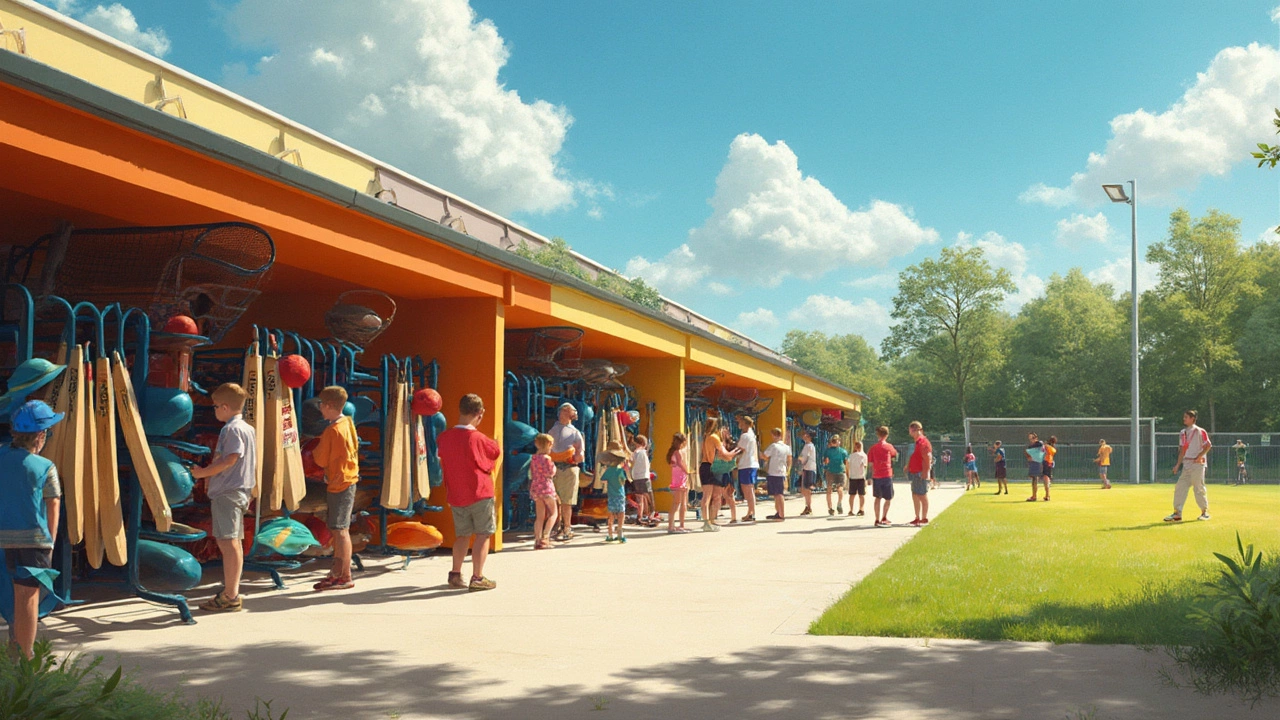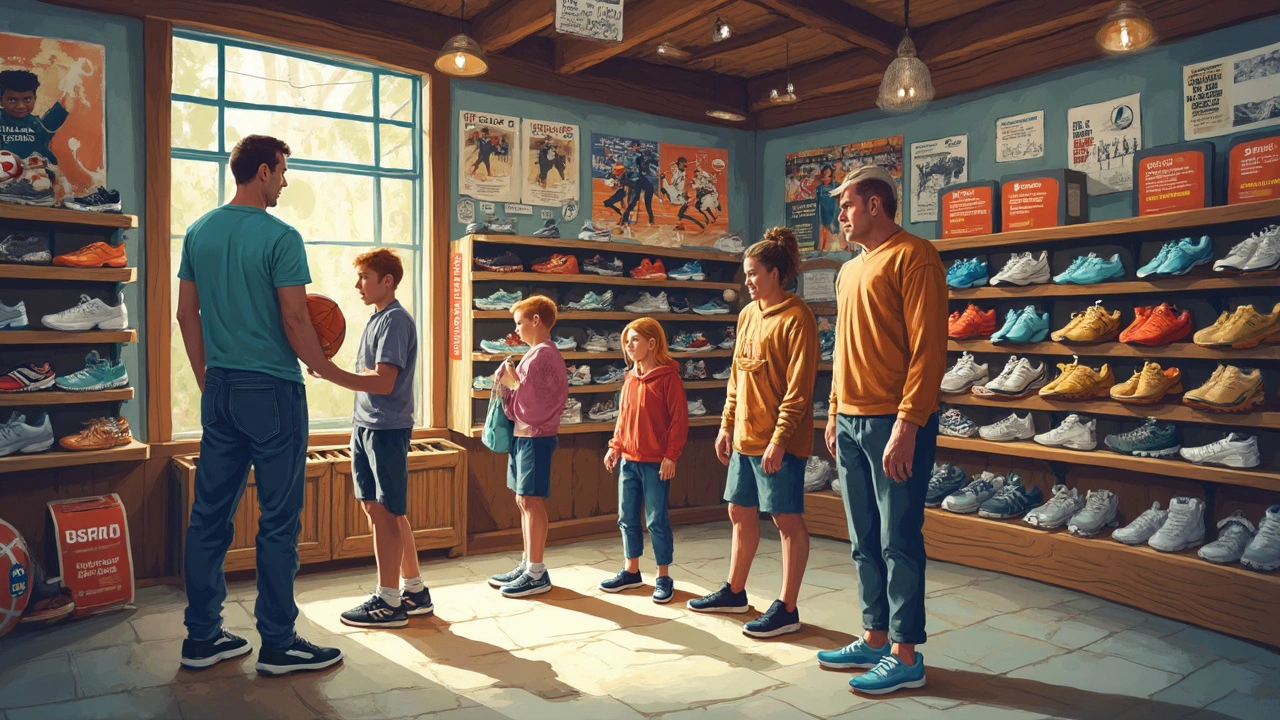Sports Equipment and Facilities: What Really Matters for Players and Fans

Ever stood in a sports store and wondered why some basketballs cost more than others, or why gyms spend so much on certain flooring? Sports gear and facilities can make or break your experience—whether you’re playing for fun or pushing for a win.
Sports equipment means more than just balls, rackets, and bats. It’s also the safety gear, proper shoes, even training tools you might forget about, like cones and resistance bands. These little things aren’t just extras—they directly shape how a game feels and how safely you can play.
And it's not only about what you use, but where you use it. The surface under your shoes, the lighting above you, even the size of the locker rooms all count. Ever played soccer on a bumpy field? You know it’s not just about skill. Good facilities aren’t just for looks—they can help prevent injuries, boost performance, and honestly, they just make sports way more enjoyable.
- Defining Sports Equipment: Beyond the Obvious
- Exploring Sports Facilities: From Fields to Complexes
- Choosing the Right Gear and Venue
- Smart Tips for Safe and Enjoyable Play
Defining Sports Equipment: Beyond the Obvious
When most people think of sports equipment, they imagine balls, bats, rackets, and helmets. But that’s just skimming the surface. Pretty much anything physically used to play, train, or compete in a sport counts as equipment. In soccer, sure, there’s the ball and cleats, but also shin guards, goalie gloves, and even water bottles lined up on the sidelines.
Training aids are a big part of the picture now too. Resistance bands, cones, ladders, agility hurdles—these tools might not be seen on game day, but coaches and players rely on them every week to build skills and reduce injuries. Even wearables like fitness trackers and heart-rate monitors fit right in, and some pro teams track athletes’ steps and sprints in real-time to avoid overtraining.
Let’s not forget the small stuff either. Mouthguards, compression sleeves, specialized tape, and grip powder all play their role. And in sports like swimming, something as simple as a high-quality cap or goggles can shave seconds off your time—not just by cutting drag, but by letting you focus on performance instead of discomfort or foggy lenses.
What you use changes with the sport and the skill level. Little league baseballs are softer and bigger than the standard, to keep young kids safe. Tennis balls are slower for beginners, and even basketball hoop heights can get adjusted for different age groups. No wonder there’s an entire industry just for sports equipment—it’s not one-size-fits-all.
Check out how some common types of gear show up in different sports:
- Personal gear: Uniforms, footwear, gloves, helmets
- Game gear: Balls, nets, sticks, bats, rackets
- Safety gear: Pads, guards, mouthpieces, goggles
- Training tools: Resistance bands, cones, agility ladders, foam rollers
If you’re buying, invest in the best gear you can afford for your sport—even little upgrades can help cut down on aches, boost your skills, and keep your head in the game longer. It’s not just about having the right stuff, but using gear that fits your needs and level.
Exploring Sports Facilities: From Fields to Complexes
Not all sports facilities are created equal. The basics are obvious—think basketball courts, soccer fields, swimming pools—but dig a little deeper and you’ll see just how much variety there is out there. The surface, size, and location all play a role in how fun and safe your game can be.
Outdoor spaces cover a lot: grass football fields, clay tennis courts, sandy volleyball beaches. Then you have indoor setups, from professional gyms with hardwood floors to squash courts and even ice skating rinks. Want something bigger? Multi-sport complexes are massive hubs that let you switch from running on an indoor track to shooting hoops, all under one roof.
Fun fact: FIFA, the big name in soccer, requires specific field dimensions for official matches—between 100–110 meters long and 64–75 meters wide. The smallest details can totally change your game. Even lighting matters; good lights extend practice hours and reduce accidents. Think about a school gym versus a state stadium. You feel the difference the moment you step inside.
Quick glimpse at typical facility sizes for popular sports:
| Sport | Typical Facility Size |
|---|---|
| Basketball Court | 28 x 15 meters (FIBA standard) |
| Soccer Field | 100–110 x 64–75 meters (FIFA range) |
| Tennis Court | 23.77 x 10.97 meters (doubles) |
| Swimming Pool | 50 x 25 meters (Olympic) |
Here’s what you should notice next time you check out a sports facility:
- Can you see lines and markings clearly?
- Is the floor or ground in good shape, with no slippery or uneven spots?
- Are locker rooms and bathrooms clean and accessible?
- Is there enough space for fans and team benches?
These details often separate a decent place from a great one. Whether you're practicing or playing in a big tournament, the right setup boosts both your confidence and performance.

Choosing the Right Gear and Venue
If you’re serious about your game, you can’t just grab the first ball or head to the nearest field and expect the best results. Picking the right sports equipment and sports facilities matters way more than most folks think. It’s not about being fancy; it’s about comfort, safety, and getting more out of every match or workout.
Let’s talk sports gear first. Every sport has specific needs, and using the wrong equipment can backfire. For example, basketball shoes really do offer more ankle support than regular sneakers; that’s no marketing gimmick. And did you know that wearing the right helmet in cycling can reduce the risk of head injury by up to 85%? That’s a stat worth paying attention to.
- For team sports like soccer or football, check the ball’s material and size—there are youth and adult sizes, and playing with the wrong one can mess with your technique.
- If you’re into racket sports, try out a few rackets or paddles before buying. Grip and weight completely change your swing and control.
- Don’t skip on personal safety gear like mouth guards, padding, or knee braces if the sport calls for it. These aren’t just for showing off—they’re about avoiding injury.
- Give some attention to clothing. Moisture-wicking shirts or socks designed for your specific activity can stop blisters and chafing.
Now, about choosing a sports facility—don’t just go for the closest or the fanciest. You want a place that’s safe, well-kept, and fits your game.
- Check the field or court surface. Bad turf or uneven floors cause sprains and strain muscles.
- Good lighting is a must, especially for sports that run into the evening. Dim lighting leads to missed balls and twisted ankles.
- Look for proper ventilation and clean facilities. It sounds boring, but stuffy rooms or dirty locker rooms can put a damper on things fast.
- Does the facility provide first aid or have staff who know what to do in emergencies? That should never be overlooked.
| Sport | Essential Equipment | Ideal Facility |
|---|---|---|
| Soccer | Cleats, properly sized ball, shin guards | Flat grassy or turf field with clear markings |
| Basketball | Bounce-tested ball, supportive shoes | Indoor court with even flooring and bright lights |
| Tennis | Right weight racket, non-slip shoes | Court with smooth surface and net at regulation height |
So, next time before you play, take a minute to think about both what you’re bringing and where you’re playing. Getting these details right doesn’t just make you play better—it keeps you safer and makes sports way more fun.
Smart Tips for Safe and Enjoyable Play
No one really wants to get hurt or have a boring time, right? Making smart choices with sports equipment and sports facilities takes just a bit of know-how. Here’s what you need to keep things fun and risk-free, whether it’s a pick-up game or an intense tournament.
- Check Your Gear Regularly: Even the best training gear wears out. Inspect balls, rackets, and protective gear before every use. Cracks or fraying can weaken equipment and make accidents way more likely.
- Pick the Right Footwear: Slipping can ruin your day or even put you on the bench for weeks. Use shoes designed for your sport and for the surface you’ll be on—cleats for grass, non-marking soles for gym courts, etc.
- Stay Hydrated and Rested: Dehydration and fatigue send injuries skyrocketing. Add an extra bottle of water and don’t skip warmups, even if you’re late. Your muscles need it.
- Know the Facility Rules: Most sports facilities have posted rules about usage times, equipment allowed, and safety requirements. Follow these—from helmet rules in the skate park to weight limits in a gym. It’s not just red tape; it keeps everyone safer.
- Use Safety Gear Every Single Time: Helmets, pads, mouthguards—they aren’t just for pros. Proper sports equipment can cut down the risk of serious injuries. A mouthguard, for example, can drop the chance of dental injuries by up to 60% in contact sports.
Here’s a quick look at how common safety measures really cut down on problems. If you ever doubted the value of gear, this should clear things up:
| Safety Measure | Injury Risk Reduction |
|---|---|
| Wearing Helmets (Cycling) | Up to 70% fewer head injuries |
| Using Correct Shoes (Court Sports) | 30% drop in ankle sprains |
| Warming Up Before Play | Reduces muscle pulls by 50% |
Last tip—don’t ignore little pains or stuff that feels off. Minor injuries become major fast if you push past them. If you feel something's wrong, take a break. Smart players are the ones who get to play the longest.
